As we’ve seen from recent news headlines, you cannot take safe drinking water for granted. When people are worried about the quality of their tap water, they often turn to bottled waters. Today, bottled water is a growing industry and there are dozens of brands to choose from, but are all brands created equal?
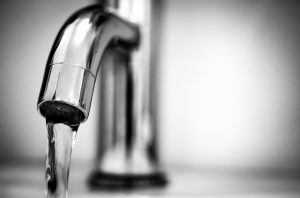
Testing different brands of bottled water is a simple science project that can be completed using TestAssured’s 4 Test Kit Set for Schools and Science Fairs. This set includes 4 test kits and can be used by school students in third grade and above to complete a variety of science projects like this one.
Supplies
The first thing you need to do is gather your supplies:
- Test Assured 4 Test Kit Set with TD Meter
- Four cups
- Tap water
- 3 different brands of bottled water
- Paper towels
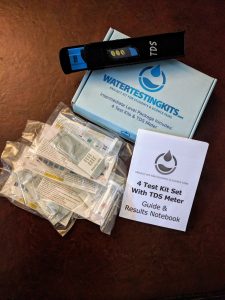
Preparation
To prepare for the tests, you’ll need to gather your water samples. We used three popular brands of bottled water and tap water for the control. You’ll need to pour your water samples into cups for the first test. Now is a good time to label your vials and write your water sources in the results notebook.
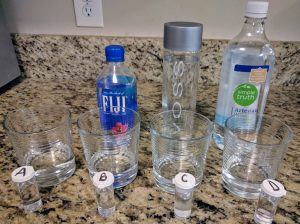
Testing
The first test you want to start with is for total dissolved solids, using the TDS meter. The meter will not fit in the test vials, so it is easier to complete this part of the experiment while your samples are still in cups. To perform the TDS test, simply turn on the meter and submerge the prongs in the samples. Rinse the meter with clean water between each test. Record your results in the results notebook.
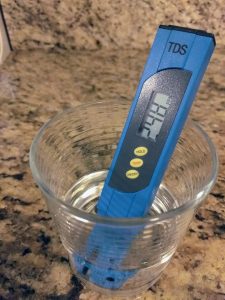
After completing the TDS test, you will need to pour your samples into the vials you labeled. Do this over a sink and be sure to wipe up any spills, so you don’t contaminate the test strips.
Before you get started with the tests, now is a good time to make some visual observations. Take notes about how clear or cloudy your samples look. Are there any visible particles floating in any of the samples? These observations can be written in the “Notes” on the last page of the results notebook.
Now you’re ready to get started with the rest of the tests. It’s easiest to work with one sample at a time. Follow these instructions to complete the remaining tests.
Alkalinity/pH/Hardness Test
- Remove the test strip from the packet labeled, “ALK/pH/Hard”
- Pick up the strip on the end with no pads
- Dip the strip in the sample for one second and remove
- Hold the test strip level and wait 10 seconds
- Place the strip as shown in the picture and compare to the color chart for alkalinity, pH, and hardness
- Record your results in the results notebook
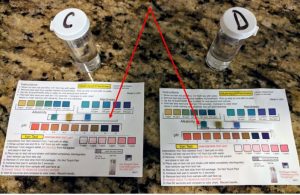
Total Chlorine/Copper/Nitrate/Nitrite Test
- Remove the test strip from the packet labeled, “CL/CO/NA/NI”
- Pick up the strip on the end with no pads
- Dip the strip in the sample three times and remove – DO NOT SHAKE OFF EXCESS WATER
- Hold the test strip level for 2 seconds
- Place the strip as shown in the picture and compare to the color chart for chlorine and copper
- Wait 45 seconds before reading the results for nitrate and nitrite
- Record your results in the results notebook
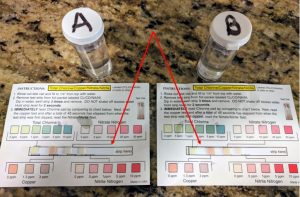
Iron Test (Complete this test last)
- Remove one iron reagent tablet from the foil packet and place in test vial (the reagent could alter the results of other tests which is why the iron test is completed last)
- Place the cap on the test vial and shake for approximately one minute, until the tablet is completely dissolved
- Remove the test strip from the packet labeled, “Iron Test”
- Dip the strip in the sample for 2 seconds
- Shake the strip once and wait 60 seconds
- Place the strip as shown in the picture and compare to the color chart for iron
- Record your results in the results notebook
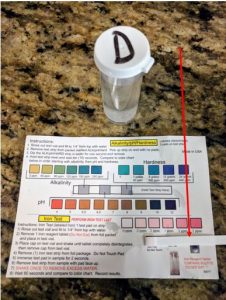
Repeat all three tests for each of your samples.
Results
Now that you have completed each of the tests on your four samples, it’s time to look at your results. Ask yourself these questions:
- Did the tap water contain more contaminants than the bottled water?
- Was there a difference in the results among the assorted brands of bottled water?
- Is it worth paying more for bottled water than tap water?
- What results did you find the most surprising?
Record your answers on the “Notes” page. You can use clear tape to fix the test sticks to the color charts to display your results for your science fair project.
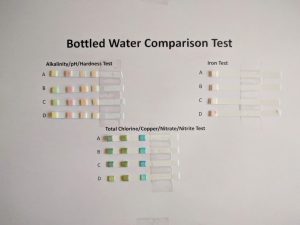


I need help on the science project